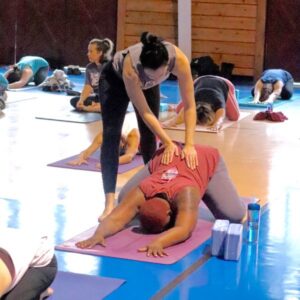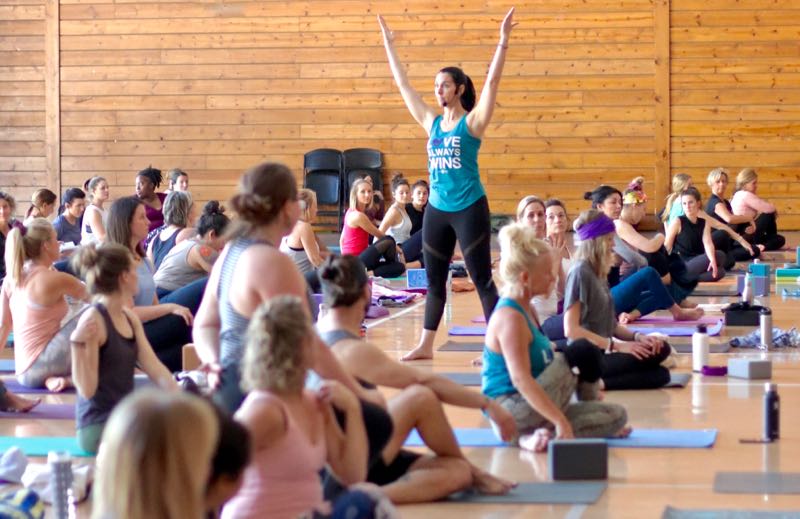 By Jonnie Goodmanson, Director of Education for Holy Yoga Global
By Jonnie Goodmanson, Director of Education for Holy Yoga Global
How can exercise help us process our pain and move forward?
Jen sought out a Holy Yoga class to move more and alleviate back pain; she had heard yoga helps with that. She had no idea she would find a place to process her trauma, meet with God and work through her emotional pain. Volumes of research are beginning to show us there are many forms of learning. Traditionally, we consider thinking about something as the best way to learn and implement information. Research is beginning to show what many have known for years; learning through movement is the best way to solidify knowledge and position yourself for change. This takes exercise to greater levels of benefits like emotional processing, retraining of our nervous system and creating new thought patterns. Add your faith to these, the agent, and purpose for your desire to change, and you have permanent and lasting change.
Understanding Trauma
The National Council asserts that up to 70% of adults have experienced traumatic events in their lifetime. Trauma is defined as a distressing or disturbing event. When these events are experienced and not processed through it can cause anxiety, depression, and unhealthy thought patterns. When one has experienced trauma, there is often a “getting stuck” emotionally in the places affected by what they experienced. When one encounters a stimulus that reminds them of their trauma (they can unconsciously be having the experience), it causes them to re-live that experience again; we call that a trigger. Our faith is a critical component to processing through trauma as we often make assumptions about ourselves based on the event. It is vital that we understand the power outside ourselves working in us that helps us through and allow us to process the truth of who we are.
Jen sought out a Holy Yoga class to move more and alleviate back pain.

Trauma comes in many forms: medical emergencies, abuse, neglect, witnessing a disturbing event (in the event of first responders), to mention a few. These can affect us mentally, emotionally, spiritually and physically. No matter what the distressing event was the person experiencing it likely had little control over the event. This loss of control causes fear that we will experience it again. In cases of trauma, movements like those found in yoga help individuals struggling with PTSD and its lasting effects. Due to yoga’s gentle nature and use of breathwork, a calming effect is made on the central nervous system during periods of discomfort, allowing the practitioner to go through the process of experiencing discomfort and leaving the movement when needed. A restored sense of control over their body.
Exercise as a Support for Healing Trauma
Various kinds of exercise, including yoga, are beneficial for aiding the healing from these experiences. The first benefit is encouraging the processing of the experience to be filed away as they create a simulation of discomfort, release, and resulting relief. Let me explain. Yoga, which is simply the practice of linking your breath, thoughts, and movement, takes you into a pose that is potentially uncomfortable-just like a trigger. You are encouraged to be in that discomfort, breathe through it, and come out of it when you are ready. This shows one who has experienced trauma two things: you get to control when the discomfort ends, and you get to breathe through it and make it to the other side of the experience.
The control of when the discomfort ends is critical, as they likely had no control over the initial trauma taking place. In cases of abuse, car accidents, and emergency medical situations, the loss of control is terrifying. Someone who has experienced trauma often walks around, waiting for the other shoe to drop, living in fear of it happening again. The second aspect of the benefit is the ability to choose how deeply you go into a pose or movement. Again, the power of choice leads to confidence and a sense of responsibility over emotions and fears. God gives us the opportunity to come and lay the experience at His feet and trust His will to be done. Lastly, relief. They leave the pose, feel better, and see they got through the difficult moment and are stronger on the other side of it. After class, one can apply those truths in the moment of emotions, stressful situations, and triggers outside of the class. We call this “taking your yoga off your mat.”
Finally, since group exercise has a community component to it, you get the added benefit of what God created us for – to do life with others. God is communal in nature, 3 in one, Father, Son and Holy Spirit. He desires for us is to “bear one another’s burdens” (Galatians 6:2). We get the privilege of holding space for one another’s pain and suffering while they work it out with the Holy Spirit. That is the true nature of community and friendship. This elevates our classes from just exercise to a healing environment where we feed one another spiritually. Touch is another aspect of group fitness that plays a more significant role than many realize. It is a language. To be considered fully healed from trauma, we need to be able to be touched with safety and comfort. You’ll see an article about this in the future.
Maintaining a healthy mindset through these tools helps us to keep our thought life rooted “on things above” (Colossians 3:2) and will help us to continue to keep our eyes on the prize of our upward call in Christ Jesus. Paul leads us to follow in his example, “I press on toward the goal to win the prize for which God has called me heavenward in Christ Jesus.” (Philippians 3:14). These are the tools for a healthy mind that can overcome trauma. In the next article, we will break down further how to support your students if you are a professional and what to look for if you are thinking of joining a community soon.







